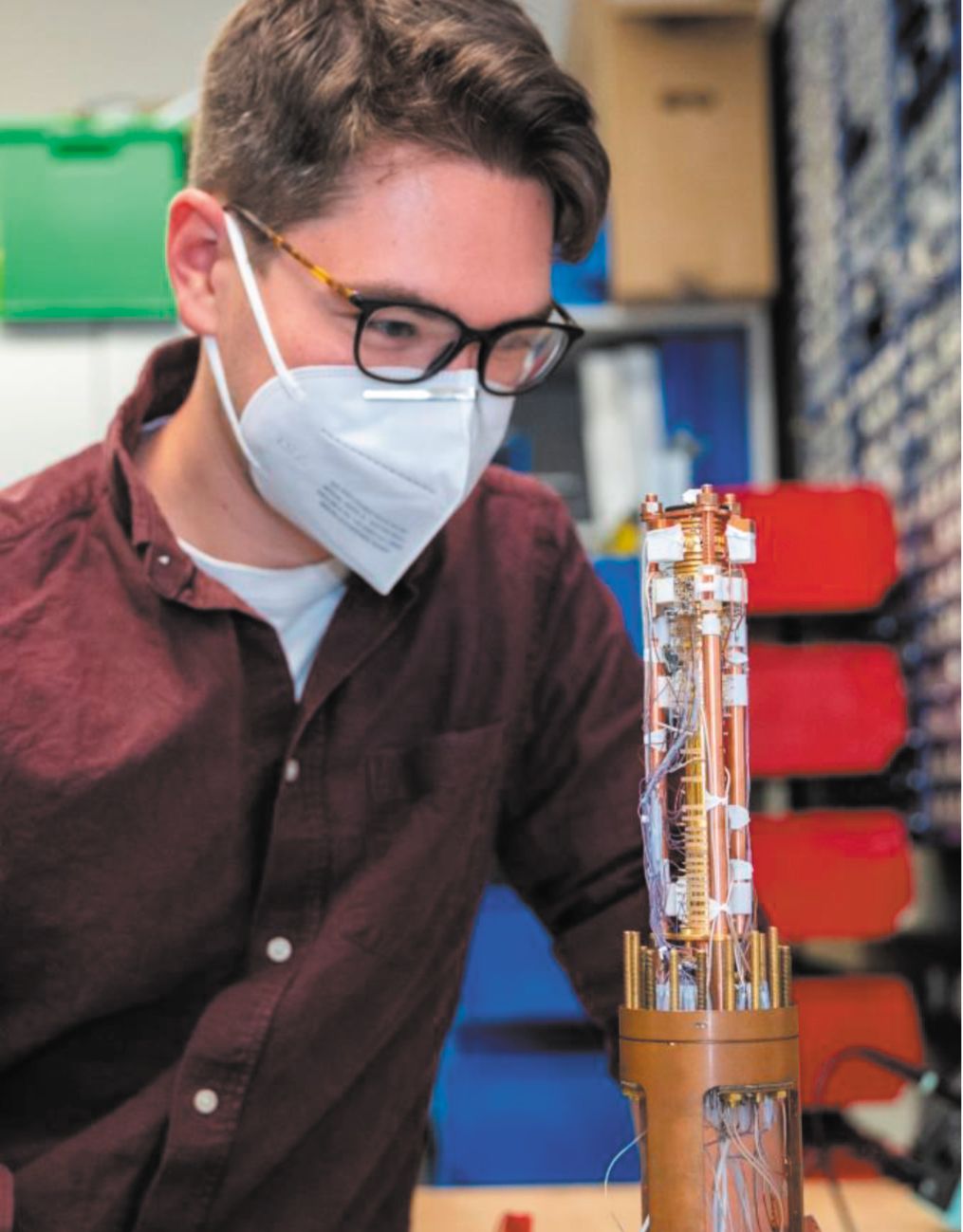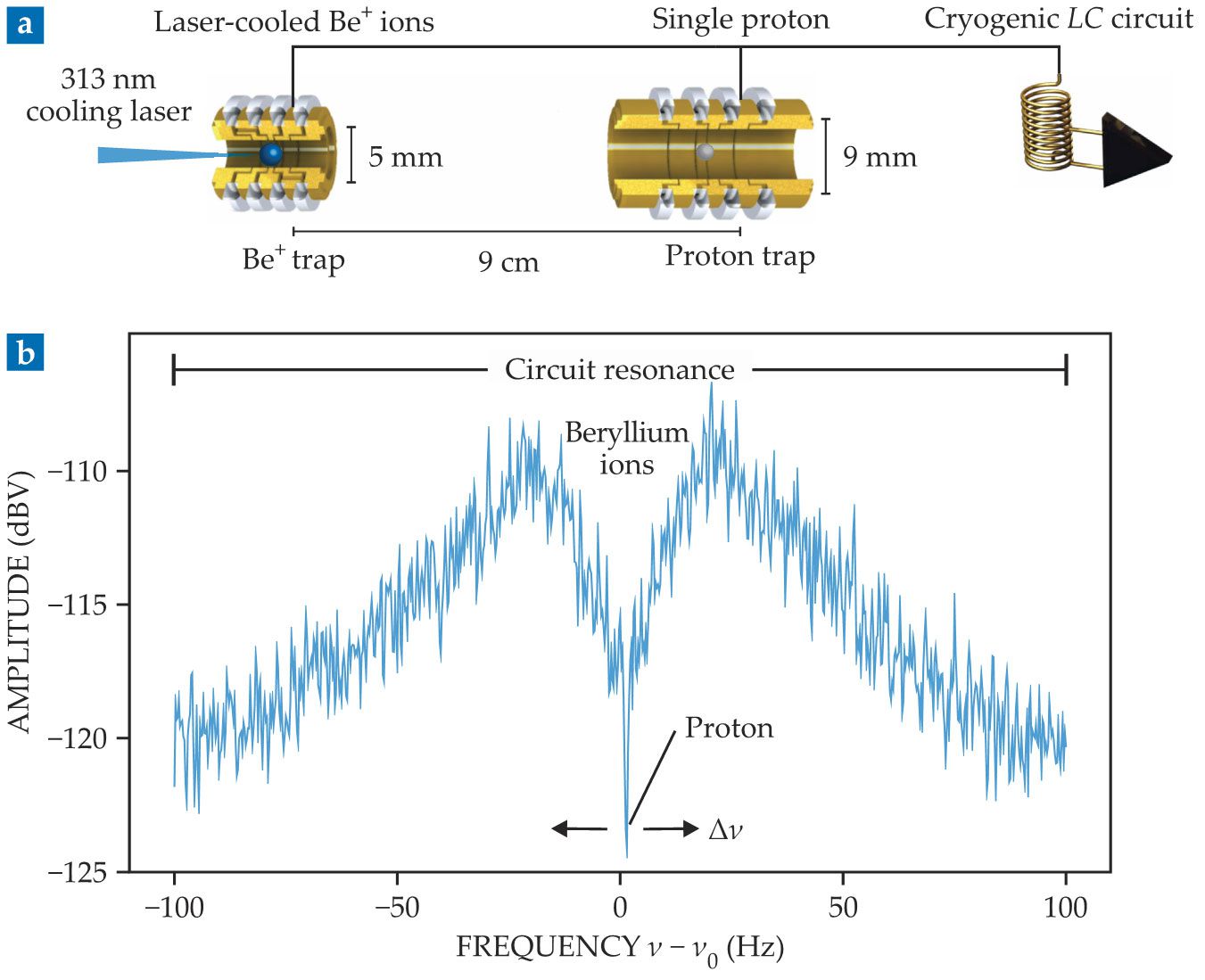A cryogenic circuit cools from afar
DOI: 10.1063/PT.3.4874
Much of modern experimental atomic physics relies on a counterintuitive principle: Under the right circumstances, zapping matter with a laser doesn’t inject energy into the system; rather, it sucks energy out. By cooling the system to a fraction of a degree above absolute zero, one can observe quantum effects that are otherwise hidden.
Laser cooling works like a charm, but only when a system’s ladder of quantum states contains a transition that the lasers can repeatedly and reliably cycle to leave the system with a bit less energy each time. Atoms of alkali metals and a few other elements are ideal. Molecules are much more challenging: Their vibrational and rotational degrees of freedom create a multitude of low-lying quantum states that can disrupt a cooling cycle. And fundamental particles such as protons, which lack internal states altogether, can’t be laser cooled at all.
Nevertheless, there’s a lot of interest in experimenting on fundamental particles at low temperature. Toward that end, researchers from the Baryon Antibaryon Symmetry Experiment (BASE) collaboration have now demonstrated a method for using a cloud of laser-cooled ions to cool a single proton, even when the proton and ions are too far apart to directly interact.
1
Figure
Figure 1.

Matthew Bohman examines the core of the BASE collaboration’s new cooling apparatus. The central gold-colored cylinder contains two electromagnetic Penning traps: one to hold laser-cooled beryllium atoms, the other to hold a single proton. (Photo by Stefan F. Sämmer, Johannes Gutenberg University Mainz.)

Try, try again
BASE, as the full name suggests, seeks to compare the properties of protons with those of antiprotons to test how exact the symmetry between matter and antimatter really is. In particular, the goal is to measure the magnetic moments, or g factors, of each particle by observing the spin flips of a single particle held in an electromagnetic Penning trap. Team members in Mainz work on measuring the proton g factor, while collaborators at CERN work on antiprotons.
The experiments require particles cooled to between 100 and 500 mK. “Warmer than that, and the spin states get muddled together,” explains Christian Smorra, leader of the Mainz group. So far, the researchers have achieved those temperatures by a technique called resistive cooling. As the proton oscillates back and forth in its trap, the moving charge induces a tiny current, called an image current, in the trap electrodes. The current is allowed to flow into an external circuit, where its energy is dissipated, and the proton energy steadily decreases.
The energy flow, however, goes both ways. Thermal noise in the circuit creates voltage fluctuations in the trap electrodes; the fluctuating electric potential jostles and warms the proton. The circuit is cooled with liquid helium to 4 K, so it might seem that the researchers can’t resistively cool their proton any further than that.
But they can—using a trick that capitalizes on the definition of temperature and the fact that the trap contains only one proton. An ensemble of particles at a given temperature is spread among states of different energies, according to the Boltzmann distribution. So a single particle in a thermalized system hops among states, and at any given instant its energy might be higher or lower. When the BASE researchers abruptly disconnect their trap from the circuit, they lock the proton into whatever state it is in at the time. That state, with a few percent chance, could be low enough in energy for a g-factor measurement.
It’s possible, then, to “cool” the proton to a significantly lower temperature than its surroundings, just by connecting and disconnecting the trap enough times until the proton is caught in a low-energy state. The process doesn’t take long—about an hour. But a full g-factor measurement campaign requires 1000 cold-proton measurements, which means that a solid month or more of experiment time might be spent just waiting for the particle to find its way into a cold enough state.
Cooling from a distance
To speed things up, the BASE team turned to an idea proposed 30 years ago by David Wineland and Daniel Heinzen: using laser-cooled ions in one trap to sympathetically cool a proton in another trap. 2 The trap electrodes are wired together, and as before, energy is exchanged via the induced image currents: from the proton to the trap electrodes to the ions, where it’s promptly laser cooled away.
It’s essential that the laser-cooled particles be ions, not atoms: Only charged particles can be confined in a Penning trap and couple to the image currents. The researchers chose singly charged beryllium ions, which have the same electronic configuration as neutral lithium atoms and are thus among the most easily laser cooled of all species. A single laser can cool a cloud of Be+ ions to 0.5 mK, so in principle, the proton could reach a temperature almost as low.
The proton cooling is still slow. For particles in the two traps to exchange energy, they need to oscillate in their traps at identical frequency. The oscillation frequency depends on each trap’s electric potential, which is hard to keep perfectly stable. The laser-cooled Be+ ions might therefore be cooling the proton for only a fraction of the time that the traps are connected.
The innovation in the new work was to also wire in the LC circuit, as shown in figure
Figure 2.

An inductor–capacitor (LC) circuit (a) amplifies the rate of energy transfer between a pair of Penning traps 9 cm apart, so the laser-cooled beryllium ions in the first trap can sympathetically cool the proton in the second trap in just seconds. (b) The circuit’s noise spectrum contains a bump at the circuit resonant frequency ν0 = 479 kHz, with nested dips marking the Be+ and proton resonances. The proton trap is slightly anharmonic, so as the proton cools, its resonant frequency shifts. (Adapted from ref.

The drawback is that, once again, the thermal noise in the circuit leaks into the traps and heats the particles. Still, because the laser-cooled Be+ ions are continuously cooling the proton at the same time as the circuit is heating it, the system can settle into a steady state with the proton much colder than the circuit.
Resonance upon resonance
To monitor the system, the researchers read out the circuit’s noise spectrum, as shown in figure
The researchers use the spectrum to verify that the resonant frequencies all match. They also use it to track the proton’s temperature. Typically, in experiments on trapped particles, it’s desirable for the trap potential to be as close to perfectly harmonic as possible. Then, the particles oscillate at the same frequency no matter their energy. But here, the researchers deliberately made the proton trap slightly anharmonic. As the proton cools, its frequency shifts.
The frequency-spectrum measurements revealed that the proton was cooled to 2.6 K. Relative to the 100–500 mK needed for a g-factor measurement, that number might seem unimpressive. But the fact that it’s more than 80% lower than the LC circuit temperature of 15 K is an encouraging demonstration that image-current cooling is possible.
The LC circuit was cooled with liquid helium at 4 K; its temperature was so much higher than that because it was heated by the amplifier that was used to read out the noise spectrum. Under the best of circumstances, that heating is limited to a couple of degrees. But as an amplifier ages, the heating problem worsens.
“It just happened that by the time we got everything else working, the amplifier was old,” says Smorra. “That’s experimental physics for you.” Swapping out the amplifier for a new one will reduce the whole system’s temperature by a factor of 3—not quite low enough for a g-factor measurement.
The BASE researchers expect that the essential improvement could come from tinkering with the trap frequencies. In the proof-of-principle experiment, both traps were tuned to the peak of the LC circuit’s resonance. That arrangement maximizes the rate of energy exchange between the two traps, but it also maximizes the rate of heating from the circuit; detuning the frequencies slightly would decrease both rates. Detuning too much, of course, will negate the advantage of using the circuit in the first place. But in between, there’s a range where the sympathetic-cooling rate should have enough of an advantage to push the proton to the desired temperature.
“Once we optimize the setup, 100 mK certainly seems possible,” says Bohman, “and even below that is maybe something we can do.”
Beyond protons
An LC circuit isn’t the only possible way to use one set of trapped particles to cool another. The most straightforward approach is to put both sets of particles in the same trap, where they can directly exchange energy and approach a common thermal equilibrium. Another possibility other researchers are exploring is to keep the particles in separate traps but bring those traps close enough together that the particles can exchange energy through their Coulomb interactions.
The big advantage of the circuit-mediated approach, though, is its adaptability. Because the particles in their respective traps never come close together, it doesn’t matter if they attract or repel, chemically react, or even annihilate each other.
The flexibility bodes well for the BASE collaboration’s experiments of interest, in which they hope to cool antiprotons just as easily as they cool protons. The antiproton setup could use the same positively charged Be ions as in the proton setup; the only necessary change would be to reverse the antiproton trap’s electric potential to account for the particle’s negative charge.
But the possibilities don’t end there. Molecules of two or more atoms, when cooled into the quantum regime, offer a range of ways to test fundamental physical laws (see the article by Dave DeMille, Physics Today, December 2015, page 34
Another possible target is highly charged ions, of interest for testing the theory of quantum electrodynamics (see Physics Today, December 2012, page 22
References
1. M. Bohman et al., Nature 596, 514 (2021). https://doi.org/10.1038/s41586-021-03784-w
2. D. J. Heinzen, D. J. Wineland, Phys. Rev. A 42, 2977 (1990). https://doi.org/10.1103/PhysRevA.42.2977
More about the Authors
Johanna L. Miller. jmiller@aip.org
